Artist Spotlight: William Estrada

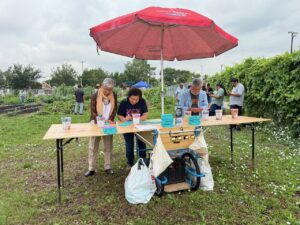
William Estrada is the lead artist working with the Little Village Environmental Justice Organization as part of the Strength Through Solidarity initiative led by the Mural Arts Institute. In addition to being an artist, Estrada is an educator whose work focuses on equity, migration, cultural recognition, and community empowerment, especially within historically marginalized groups. Raised in California, Mexico, and Chicago, he uses public art and teaching to spark dialogue and amplify local narratives.
William currently teaches at UIC’s School of Art and Art History and Telpochcalli Elementary School, and has worked with numerous arts and education organizations across the country. His practice blends art, politics, and education to challenge norms and reimagine shared spaces through collaboration and storytelling. He is active with groups like Mobilize Creative Collaborative, Chicago ACT Collective, and Justseeds Artists’ Cooperative. Estrada has presented nationally on art and social justice, receiving multiple awards, including fellowships from the National Association of Latino Arts and Culture and 3Arts.
His current research explores community-based projects that address power, race, and access, aiming to build just futures through slow, intentional collaboration. Learn more about him in this interview:
Tell us a bit about yourself and your art practice:
I was born to migrant workers in Southern California. I grew up between Guadalajara, Tonala, San Jose de las Moras, and San Francisco de Rivas in Jalisco and the South West Side of Chicago. I’ve been a community artist in Chicago for the last 29 years, primarily working on the South and Southwest sides of the city. Over the years, I’ve learned from amazing community artists that art can be a tool to amplify, celebrate, and organize with historically marginalized communities. It is through creating art, imagining different worlds, celebrating the joy that exists in the neighborhood, and amplifying the laughter that we hear on the stoops on the block that we can reclaim stories that are passed down from generation to generation. We build community by imagining and gathering with our neighbors and friends, and it allows us the flexibility and space to radically imagine the world we want to create for ourselves and each other.
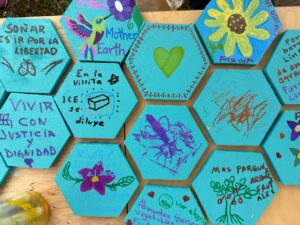
These are the experiences I grew up with, and I want to ensure that the people I work with, regardless of their age, can see themselves as knowledge producers and reclaim the brilliance they carry through art-making. As a young person, art class was the only place where there was no wrong answer. It was Mr. B at Marquette Elementary calling me an “Artist” in 4th grade when I colored the Geography maps he assigned and it was Mrs. Cheryl Stallings at Gage Park High School in Chicago’s Southwest side, using prompts to spark our curiosity and to encourage everyone in art class to think beyond our own experiences and imagine the places we wanted to build for our future selves; all along celebrating our culture, our personal experiences, and honoring the multiplicity of stories that made us whole.
The artwork I create and the teaching I participate in are influenced by popular education and social justice art education. It is an attempt to recreate those moments that influenced my thinking early on in my education. Moments of inquiry, moments of excitement and curiosity, moments where people are seen and they’re brilliance is celebrated and acknowledged. People have continuously built spaces for me to teach and learn, allowing me to grow, be curious, and ask questions. This foundation has enabled me to make spaces that I could have never imagined being part of in the past. I aim to create and amplify these spaces for others, allowing people in the neighborhoods I serve to be fully seen and celebrated through the creation of art in public spaces that are part of their homes.
What is happening with the Strength through Solidarity Initiative at Little Village Environmental Justice Organization (LVEJO)?
The Strength through Solidarity Little Village Dreams Team, made up of myself and LVEJO staff, Edith Tovar, Yoshi Vazquez-Gomez, Ana Solano, and Nancy Meza, has been dreaming up community workshops that invite community members across Little Village to imagine a more environmental just neighborhood, by having more nature in our neighborhood and learning how we can take care of the water, air, and soil in the neighborhood.
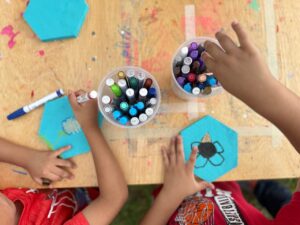
The LVEJO Staff have been working hard on programming toxic tours, air monitoring, food distribution, and community art workshops. The toxic tours consist of visiting various important community sites that inform the public about the struggle for environmental justice in Little Village, while taking participants on an interactive tour that promotes active learning and creates opportunities for family and friends to learn and participate in environmental justice. The air monitoring campaign is driven in collaboration with residents concerned about pollution from nearby industrial areas. The efforts include deploying air quality sensors provided by LVEJO to community members, enabling them to monitor high levels of PM2.5. Additionally, the project monitors the effects of the industrial corridor, which comprises warehouses, freight, and packaging facilities that contribute to traffic and pollution. Truck traffic, including freight trucks, buses, and diesel trucks, contributes significantly to traffic congestion and pollution, particularly PM2.5. Food Distribution is led by the farm team, which runs a 1.3-acre farm in Little Village Park. Honoring the neighborhood’s existing expertise and providing opportunities for people to reconnect with the land and the cultural foods that community members are connected with, the farm team has been growing food and distributing it back to community members as part of their Mutual Aid Food program.
These various ongoing campaigns and programs within LVEJO have had a significant impact on the Strength Through Solidarity Little Village Dreams Team and the way we approach our community engagement and programming. The community engagement workshops we had envisioned were disrupted by the current attacks on our community, which made it unsafe to gather in public spaces and hold large-scale public programming. We slowed down and began to rethink ways that we could engage with community members through smaller interactions and programming that was already happening, taking into consideration safety plans that could help us provide a safe space for community members to gather and create without the fear of ICE kidnapping our family and neighbors.
The team has been slowly gathering scales/feathers with eager participation from Little Village residents. Community members are asked to share their dreams for environmental justice in Little Village. We ask what type of nature they want to see more of in the neighborhood and inquire how we can take care of the air, water, soil, and our health. Through these conversations, we invite people to draw, generate symbols, poems, and text on the scales/feathers we have hand-cut, which assist in sharing their environmental justice dreams with others. We are in the process of creating over 200 scales and feathers that will be used to generate a wood sculptural mural installation of Quetzacoatl.

The Quetzacoatl will be installed on a fence in the Little Village Farm in September and October, with plans to create parts of the feathered serpent across the neighborhood to mimic a Quetzacoatl weaving in and out of the neighborhood, through the earth, honoring the wind, learning about our culture, reconnecting to agriculture, and indigenous knowledge. The myth of the Quetzacoatl symbolizes creation and its gift of knowledge and culture to humanity; it is associated with renewal and hope for a better future, and the reclamation of our stories to the land.
I am excited about this public art project and the conversations it will inspire through the creation of this mural.
Are there any challenges or successes you would like to share with us?
When we started this project, we were eager to get started and struggled to slow down. Strength Through Solidarity Fellowship reminded us to slow down and take time to deepen our relationships with one another and with the community. It challenged us to rethink our approaches to community engagement. Visiting the South Baltimore Community Land Trust in South Baltimore and Vietlead in Camden, NJ, had a significant impact on the development of the public art project, while also serving as a reminder of the environmental injustices present across our neighborhoods. Walking in South Baltimore and Camden was very similar to walking in Little Village. The industrial corridors, filled with pollution-generating industries and years of disinvestment and resource theft, were evident in the cracks on the cement we walked on and in the thick air we struggled to breathe. We were inspired by the people and neighbors working together to dismantle years of oppressive systems that divide and pit resources against us. We witnessed how community members are building sustainable zero-waste homes and maintaining community gardens that honor the food that reminds them of home. These visits created space for us to take deeper breaths while dreaming of the possibilities of this project within our neighborhood, and allowed us to weave experiences, friendship, and admiration across cities.
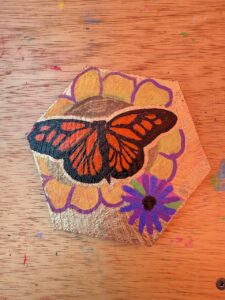
We also encountered various challenges due to the ongoing attack on our community and the kidnapping of our family members, friends, and neighbors. We had to considerably limit the public gathering we were initially planning and think through how we could generate the impact we wanted to have across Little Village through smaller interactions that invited people to be vulnerable and celebrate their resistance through collaborative art making in communal spaces that felt safe. We are limiting gatherings but generating opportunities for smaller, more intimate relationships that allow this project to exist now and expand through upcoming months, enabling us to build long-term relationships that move at the speed of community.
How does this project use art for education and social change?
The Strength Through Solidarity: the Art & Environmental Justice Co-Learning Initiative felt intentionally and carefully implemented to model what art for education and social change can look like in public art programs. Through transparency, equity, collaboration, trust, and slowing down, the cohort was set up with a foundation that modeled what social change looks like in action. The cohort model, in conjunction with the Strength Through Solidarity Learning Initiative and the Mural Arts Staff, created opportunities to deepen my commitment to social change by allowing time for our team to deepen our relationships with each other and the community we work in.
The Quetzacoatl Mural project aims to build on previous collaborations. We intend to continue dreaming together and creating art projects that invite more artists, community members, organizers, and cultural workers to move at the speed of trust and community in order to center community experiences and amplify the creativity already present in the neighborhoods we are currently working in.
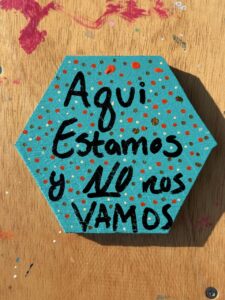
The mural begins with the prompt “What are your environmental Justice Dreams for Little Village?” and follows with “What type of nature do you want to see more of in the neighborhood? And also asks “How can we make sure corporations are held responsible for the air, water, and soil in our neighborhood and its impacts on our health?” These prompts are designed to encourage community members to engage in the conversation and explore potential solutions. The work is intended to create multiple points of entry.
The first point of engagement is in the artmaking, allowing space for people who may not have other opportunities for leisure time to create and engage in play, to make art based on their own experiences and thoughts.
The second point of engagement is when people interact with the prompt and consider how environmental justice affects them and their loved ones. They imagine possible solutions and ways they can actively engage in proposing solutions to the problems being discussed.
The third point of engagement involves actively participating in discussions to find resources and organizing connections across their experiences, thereby strengthening the existing efforts to disrupt and dismantle environmental injustice in the neighborhood.
Of course, this isn’t an exhaustive list, but it outlines a process that I hope may inspire others. There is already so much knowledge and organizing happening by people in the neighborhood that these three points of engagement simplify the complex and layered approaches people engage with environmental justice in ways that are pubic and in small actions that take place across people’s experiences.
Are there any community engagement activities that helped you shape the project?
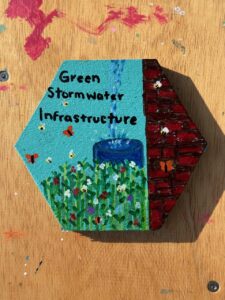
As a community artist with twenty-nine years of focus on community engagement and social justice art education, the Little Village Deams Team’s visit with South Baltimore Community Land Trust, VietLead, and Murals Arts Staff and Artists validated the work I am doing. It was instrumental in helping me reimagine the potential of how the work we do as community artists can strengthen, inform, and amplify the work already happening in our communities. There is so much more to learn, and this project has given me the time and space to reflect on what work I am doing and how I want to continue doing it. The project has provided opportunities to connect with artists and organizers across cities, who have generously shared their mentorship and space, allowing us to explore and expand the possibilities of public art making. It is this combination of intentional interactions across sectors and communities that has provided the space for me and the LV Dream Team to deepen how we want to engage with each other and our neighbors. This whole experience will have ripple effects across my practice as an artist and educator for years to come as I attempt to model what I have learned from the Mural Arts Staff, cohort members, and STS Learning Initiative in the spaces I create, teach, and lead.
Final comments about how working on this project has impacted your art practice:
The Strength Through Solidarity: the Art & Environmental Justice Co-Learning Initiative felt intentionally and carefully implemented to model what art for education and social change can look like in public art programs. The design of the program has already created ripple effects in my practice and will continue doing so. These are just a few of the many factors that are having an impact.
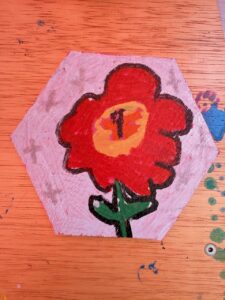
Budget Transparency
From the beginning, there was transparency on what the budget consisted of. We were provided with a contract early on, allowing us to review it. During our first meeting, we had the opportunity to ask questions, clarify concerns, and provide feedback, accompanied by a clear budget and a detailed breakdown of how it should be allocated. This is the first time in my twenty-nine years that I have been given a budget breakdown by a funder that centers on trust and autonomy, allowing for the most freedom and independence, and that provides support to create a public art project.
Equitable Pay for Artists
Within the budget breakdown, there was a budget line for the minimum amount the artist should receive. This budget allocation was extremely generous, valuing the contributions of artists in the project and ensuring their well-being and work were sustainable in the long term and throughout the project. This foundational work, undertaken at the project’s outset, provided a blueprint for how we would approach all decisions and compensate all participants in the project. This experience has given me more agency to ask for equitable pay that honors my labor and provides sustainable approaches to continue doing public art in historically marginalized communities.
Time to Wonder
The STS Learning Initiative was broken down into two years. The first year was designed for teams to learn from each other and the community they intended to work with. This involved traveling to meet other cohort members, mural arts artists, and staff. This is the first project I am part of where funders have allocated money for us to play and wonder with each other for twelve months, providing time and space for us to imagine different ways to potentially engage with our neighbors and think through new ways of creating public art. This is the first time I have had the opportunity to ponder and learn; typically, public art projects are rushed, leaving little time to reflect deeply on the process. This learning initiative was designed to create time to learn form each of the cohort members and the Mural Arts Institute staff and artists provided so many mentorship opportunities, they encourage wonder through various opportunities designed specifically for each of our interest, and it was through this build in intentional time, that genuine friendships and relationships are being seeded and watered for many years to some. I’ve used this learning initiative as an example for other foundations and granting organizations on what is possible when you approach relationships with care and support that is designed to build long-term impact both locally and nationally.
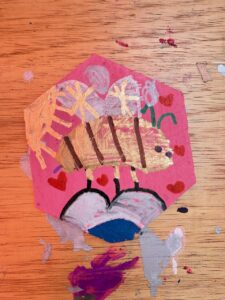
Cooperative Learning and Community Building
Having time to visit cohort members in their cities and learning about the work they are doing through walking tours, informal presentations, socializing, and art-making opportunities helped us understand the layered, intricate, and delicate work that cohort members are doing in their neighborhoods. Having the funding allocated for travel and learning from each other was exceptional and provided a level of cooperative learning and community building with cohort members that I hadn’t experienced before. This created solidarity within the Environmental Justice Sector, but it made friendships and mentorships possible for years to come. As a community artist, this experience allowed me the time to learn from different artists and cultural workers, asking similar questions to the ones I am asking in Chicago. Being able to see how they implement strategies and witness their artistic practice in real-time has allowed us to call each other, give each other feedback on projects, and serve as a sounding board for troubleshooting challenging situations.
Trust and Autonomy
Mural Arts Institute Staff and Artists honored the expertise already present in our teams and gave us autonomy in how we approached the public art project we were building. Consistently checking to see if we needed help or resources but never feeling intrusive, the MAI staff was amazing to work with and learn from. I hope that the approaches the MAI staff applied in the STS Learning Initiative are echoed across the arts and culture sector. If any of these portions could be replicated in other funding places, it would allow artists and cultural workers so much space and ability to create the work that needs to be made. These approaches seem so simple, but are rarely actually practiced in the arts and culture sector. MAI is innovative in its approaches. I hope other foundations and granting organizations will learn from the Strength Through Solidarity Learning Initiative and use it as a case study on how they should approach funding, how to support cultural arts organizations, and how to support community artists.
Portrait of William Estrada by Anthony Marcos Rea at White Sands National Park in NM.